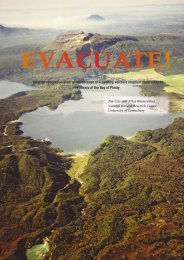Volcanoes - Ministry of Civil Defence and Emergency Management
Volcanoes - Ministry of Civil Defence and Emergency Management
Volcanoes - Ministry of Civil Defence and Emergency Management
You also want an ePaper? Increase the reach of your titles
YUMPU automatically turns print PDFs into web optimized ePapers that Google loves.
Vertical deformation in the caldera<br />
volcanoes is monitored using a lake-levelling<br />
technique, in which the whole lake acts as<br />
a level. Nearly 30 years <strong>of</strong> record from Lake<br />
Tarawera <strong>and</strong> Lake Taupo have shown regional<br />
deformation <strong>of</strong> several millimetres per year,<br />
analogous to deep sighing <strong>of</strong> these volcanoes.<br />
CHEMICAL MEASUREMENTS<br />
Volcanic regions emit gases both<br />
during <strong>and</strong> between eruptions, <strong>and</strong> changes in<br />
emission rates <strong>and</strong> chemistry <strong>of</strong> volcanic gases<br />
can help us to predict changes in volcanic<br />
activity. Volcanic gases emit through the<br />
main volcanic conduits to form fumaroles <strong>and</strong><br />
volcanic plumes, <strong>and</strong> also diffuse through soils.<br />
Some components <strong>of</strong> the gas stream react with<br />
groundwater <strong>and</strong> are essentially scrubbed<br />
when passing through crater lakes or shallow<br />
aquifers. Thus, when monitoring the volcano<br />
chemistry, it is important to consider the<br />
different emission pathways, <strong>and</strong> monitor both<br />
the gas <strong>and</strong> fluid phases.<br />
The two most abundant gases emitting<br />
from volcanoes following water vapour are<br />
carbon dioxide (CO 2<br />
) <strong>and</strong> sulphur dioxide<br />
(SO 2<br />
). These two volcanic gases behave<br />
differently in magmas, <strong>and</strong> thus, each gas<br />
provides information about activity at different<br />
depths. Carbon dioxide, for instance, has a<br />
relatively low solubility in magma compared<br />
to sulphur dioxide <strong>and</strong> water vapour. Thus,<br />
as magma starts to move from deep (~35<br />
km) in the crust toward the surface, CO 2<br />
will<br />
become progressively supersaturated in the<br />
magma <strong>and</strong> be released before other gases.<br />
When monitored periodically using airborne<br />
or ground-based techniques, increases in CO 2<br />
emissions will provide the first indication<br />
that there is magma movement at depth. For<br />
example, in 2000 at Usu Volcano in Japan, a<br />
group <strong>of</strong> scientists observed a tenfold increase<br />
over typical background levels in diffuse soil<br />
emissions prior to an eruption. The techniques for<br />
measuring CO 2<br />
through soils <strong>and</strong> in volcanic plumes<br />
have improved dramatically over the last 10 years, <strong>and</strong><br />
are being utilised to provide more insight about the<br />
behaviour <strong>of</strong> CO 2<br />
emissions preceding volcanic eruptions<br />
in New Zeal<strong>and</strong>.<br />
Sulphur dioxide emissions are easy to measure<br />
using remote techniques (COSPEC) from airborne<br />
platforms. SO 2<br />
is released from magmas at shallower<br />
depths <strong>and</strong> can also be used to detect magma movement<br />
toward the surface (within a few km <strong>of</strong> the surface). For<br />
Measuring temperatures at the Mt. Ruapehu Crater Lake. Photo: GNS.<br />
instance, preceding the 1995 eruption <strong>of</strong> Ruapehu there<br />
was an 18% increase in the concentration <strong>of</strong> sulphate<br />
ions in the crater lake over a period <strong>of</strong> 5-6 weeks,<br />
suggesting an increase <strong>of</strong> at least one thous<strong>and</strong> tonnes/<br />
day <strong>of</strong> SO 2<br />
over this time period.<br />
Changes in the ratio <strong>of</strong> gas abundances can also<br />
be used to detect changes within the volcanic system.<br />
Sampling <strong>and</strong> chemical analysis <strong>of</strong> gases from individual<br />
fumaroles as well as crater lakes can provide detailed<br />
information about the trace abundance <strong>of</strong> gases emitting<br />
from the volcano. For example, for the six months prior<br />
to the eruption at Ruapehu in 1995, scientists observed<br />
15<br />
TEPHRA<br />
June 2004

















